A campaign to erect a long overdue statue to the brilliant palaeontologist Mary Anning on the Jurassic Coast at Lyme Regis
Don't wanna be here? Send us removal request.
Link
The Mary Anning Rocks fundraising Ebay auction is live with even more items going up tomorrow! There’s lots of amazing items up for grabs from fossils to experiences to signed books to artwork so go and check it out!
#Mary Anning#ma#Anning#palaeontology#paleontology#palaeontologist#paleontologist#fossils#fossil#ichthyosaur#plesiosaur#lyme regis#dorset#jurassic#jurassic coast#mary anning rocks#victorian#scientist#women in stem#women in science#ebay#auction#fundraiser
9 notes
·
View notes
Photo

A portrait of Mary Anning, the rad as heck lady who discovered tons of Jurassic marine species.
584 notes
·
View notes
Photo
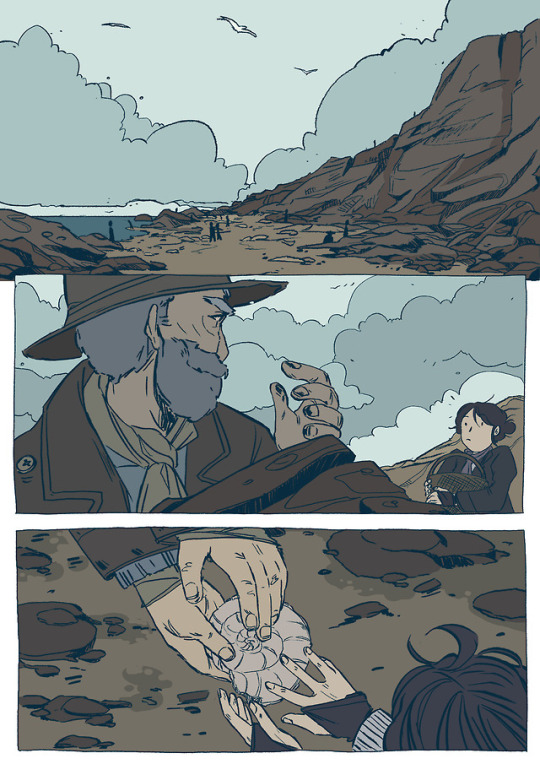
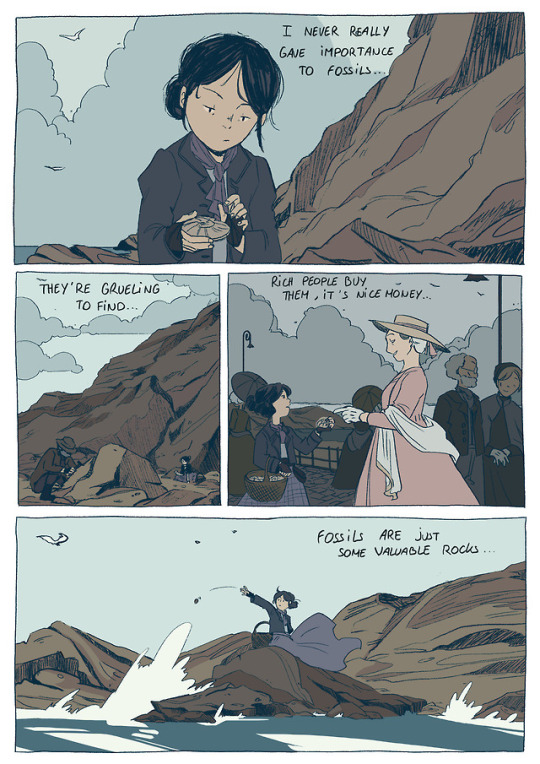

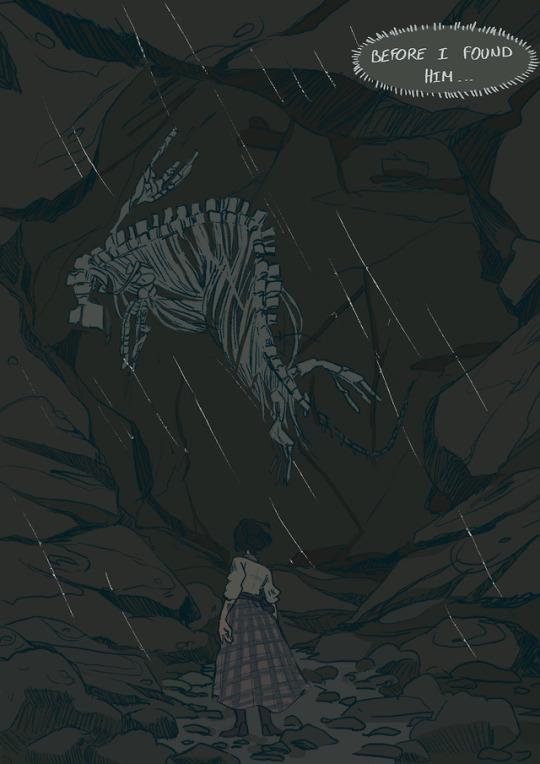
Small comic tribute to the palaeontologist Mary Anning, who discovered in the early 19th century the first fossils of an ichtyosaure. All through her life she digged out new species and exceptional fossils, her work had a huge impact on the evolutionary theory
#Mary Anning#Anning#palaeontology#paleontology#palaeontologist#paleontologist#fossils#fossil#ichthyosaur#plesiosaur#lyme regis#dorset#jurassic#jurassic coast#mary anning rocks#victorian#scientist#women in stem#women in science
61K notes
·
View notes
Text
March 9th...
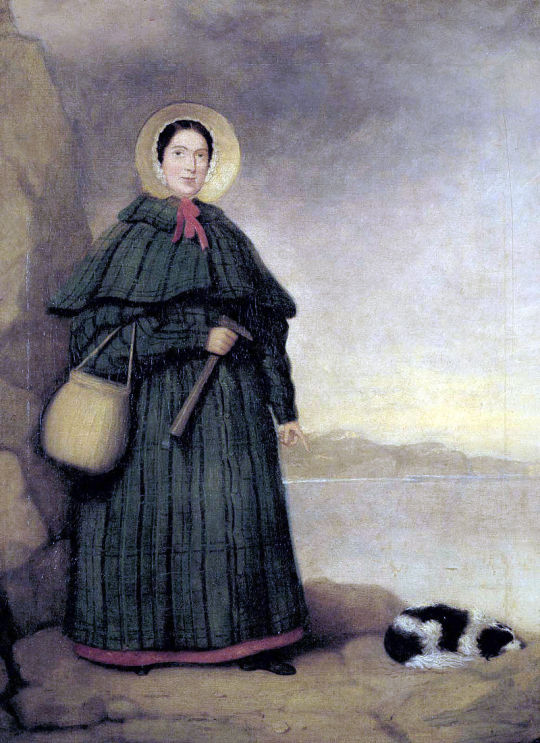
On This Day in Herstory, March 9th 1847, Mary Anning, an English paleontologist, fossil collector and dealer, known for the significant discoveries she made that changed scientific understanding regarding the history of Earth, died in Lyme Regis, Dorset, England; she was 47 years old.
Mary Anning was born on May 21st 1799, in Lyme Regis, to Mary Moore and Richard Anning. Her father was a carpenter, and both of her parents were amateur fossil hunters. The family was very poor and had nine children, though only Mary and her brother survived into adulthood. Mary was named after an older sister who died in a house fire before mary was born. Mary neary died herself when she was only a baby; she was in a field when a thunderstorm rolled in, the woman holding her sought refuge under a tree, and when a bolt of lightning struck the tree the woman died, yet Mary escaped unharmed. Mary had a few years of education, and taught herself how to read and write. But, much of her time was spent at the beach; her father frequently took her there and taught her the art of collecting fossils. These trips were almost always prosperous, as the cliffs of Lyme Regis date back more than 230 million years, a time when the area was much closer the the equator, and was inhabited by many very large creatures. The family relied on the sale of the fossils they found as a source of income. This income became even more necessary in 1810, when her father, the family’s main breadwinner, fell off a cliff and died. Just a year later, near where her father died, Mary made her first significant discovery; she found the skull, and then entire skeleton of the first known ichthyosaurus specimen.
By 1817, Mary’s discoveries attracted the attention of the British fossil collector Lieut. Col. Thomas Birch, who financially supported the family by purchasing a number of the specimens. Later, he auctioned off many of these items and then donated the proceeds to Mary’s family when they fell on particularly hard times. She taught herself geology, anatomy, paleontology, and scientific illustration; and though she lacked formal education, her discoveries, knowledge of the area, and her skill at fossil classification earned her a good reputation in the male dominated field of paleontology. Her most famous find occured in 1824, when she uncovered the first intact Plesiosaurus skeleton. After the find was authenticated, the scientific community began to recognise the importance of all the fossils that Mary recovered. She became quite the celebrity amongst paleontologists, and collectors; and as a result Lyme Regis was flooded with tourists who came to buy from her. Over her career, she discovered several Ichthyosaurus and plesiosaur skeletons, as well as a pterosaur, which became known as Pterodactylus (or Dimorphodon) macronyx, the first of its kind found outside of Germany. Additionally, she discovered the skeleton of Squaloraja, a fish thought to be a member of a transition group between sharks and rays. Many people believe her discoveries partially contributed to the theory of evolution proposed by Charles Darwin. Despite her innumerable discoveries, and the name she made for herself, Mary was often not given credit for the items she recovered. The collectors who purchased from her who went on to donate the specimens are often still credited with the item’s discovery. Many journals were written detailing her discoveries at length, yet they never even mention her name.
Towards the end of her life, Mary collected allowances from the British Association for the Advancement of Science and the Geological Society of London, which were set up in recognition of her contributions. At this time she also worked less and less as a result of breast cancer. Mary Anning died on March 9th 1847, she was 47 years old. In 2010 she was recognized as one of the 10 most influential women scientists in British history by the Royal Society.
268 notes
·
View notes
Text
Obviously we're very excited for the 16th!
Aquatic April
WHAT: a whole month of aquatic paleontological fun! make art and read about your favorite aquatic organisms from long ago!
SCHEDULE:
APRIL 1: precambrian day
a whole 24-hour period dedicated to precambrian everything! from cyanobacteria to snowball earth, we have you covered
APRIL 2: MEGA TRILOBITE TUESDAY
24 HOURS OF NONSTOP EXTREME TRILOBITE ACTION!!!
APRIL 3-13: paleozoic palooza
from the cambrian to the permian, 10 individually themed days centered around favorite critters from the paleozoic era! see calendar.
APRIL 14-20: mesozoic week
a whole week about jurassic, triassic, and cretaceous aquatic creatures (AND a whole day dedicated to the one and only mary anning)! see calendar.
APRIL 21-25: cenozoic time
5 days dedicated to aquatic organisms from the cenozoic, ranging from megaladons to basilosaurs! see calendar.
APRIL 26-27: you pick!
pick any aquatic organism, aforementioned or not, and make content about it for an ultimate aquatic april collage!
APRIL 28: living fossils
ceolocanths, gingko, and more! all your favorite really old clades that are still kickin!
APRIL 29: pride!
LGBT-themed paleoart! transtaalik greatly appreciated!
APRIL 30: fossil specimen
post any specimen you own/have found!

247 notes
·
View notes
Text
Excellent addition and well worth a listen!
Mary Anning: The Woman
Mary Anning was born in 1799 in the town of Lyme Regis on the Dorset Coast to parents Richard and Molly Anning. Out of at least nine children born to the Annings, only Mary and her older brother Joseph survived past childhood. This is despite Mary herself being struck by lightning at only 15 months old as she was being carried by another woman. Three women were killed in the lightning strike but miraculously, Mary survived.
The Anning family were poor and working class- the bottom of the pile in society. On top off this, the family were dissenters, protestants who had separated from the Church of England, who were often ostracised by other Christians. She attended a school run by the Congregationalist dissenters, though the education she received here did not extend far past reading and writing.

[Image of a drawing finished in 1842 showing the fossil shop and home Mary purchased in Lyme Regis]
Mary and her brother would frequently join their father, a cabinet maker by trade, on fossil hunting expeditions along the coastline, which they would then sell for extra money. This was a dangerous occupation and in 1810, when Mary was just 10, their father died of a combination of injuries contracted from a cliff fall and being weakened by tuberculosis. The family was left with his debts to pay and had to rely on parish support to survive.
Mary was left to take over the fossil business to provide for her family while Joseph became an apprentice upholster. Even though she lacked formal education, Mary taught herself geology and anatomy and the rest is history (and will be covered more in a Mary: the Scientist post!).
She was highly successful and by 1826 had saved up enough money to buy her own home and store, Anning’s Fossil Depot.
Once again, the dangers of Mary’s trade were shown when she narrowly avoided being crushed in a landslide in 1833 while she was out fossiling and sadly, she lost her dog, Tray, that day. In a letter, she wrote: “Perhaps you will laugh when I say that the death of my old faithful dog has quite upset me, the cliff that fell upon him and killed him in a moment before my eyes, and close to my feet … it was but a moment between me and the same fate”
In her personal life, it is well known that she was good friends with fellow fossil collector and palaeontologist Elizabeth Philpot. The two often worked together and it was Philpot who first discovered that the ink sacs Mary had discovered in belemnites could be revived and used for writing and drawing.
Another childhood friend of Mary’s, Henry de la Beche was so inspired by Mary’s finds that he painted the famous Duria Antiquior, which he then sold prints of to help in supporting Anning through her continuing financial difficulties.

[Oil on canvas reproduction of Duria Antiquior painted in 1850, based on de la Beche’s earlier 1830 watercolour]
Anning died in 1847 aged just 47 from breast cancer. Due to the pain from this, her work tailed off in the last years of her life. She is buried at St Michael’s church where there is a stained glass window, donated by the Geological Society, which Mary herself was never allowed to join, in 1850. You can still visit her grave and children and adults alike often leave fossils around the headstone for Mary.
561 notes
·
View notes
Text
Beautiful! Thank you for sharing!
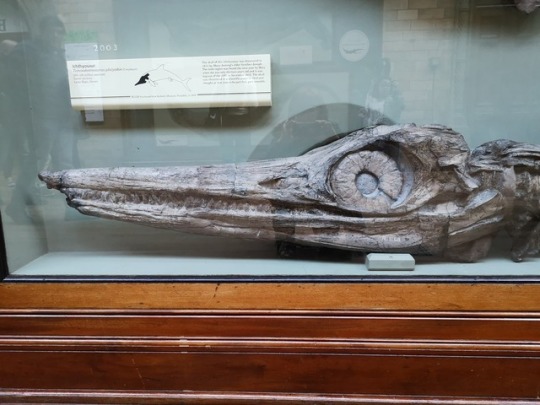
This is the first ichthyosaur to be correctly identified as such on display at the London Natural History Museum and it was discovered by the Anning family!
Mary’s brother, Joseph, initially found the skull before Mary later returned to do the painstaking and dangerous work of collecting the rest of the skeleton. The most amazing thing is they were both children at the time, with Mary only being 12.
359 notes
·
View notes
Photo


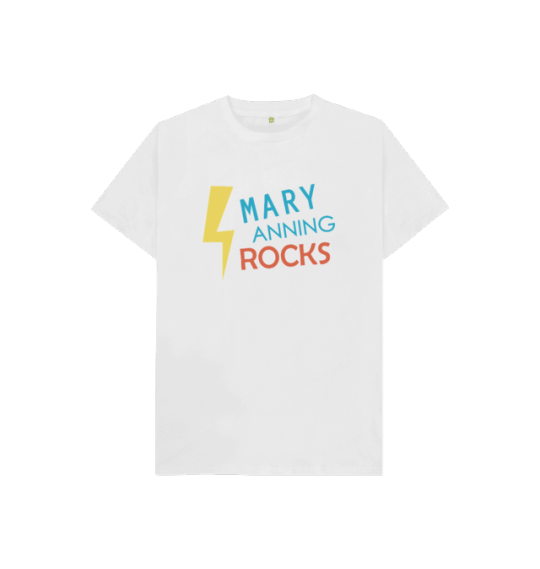



In addition to donating straight to the cause, you can also pick yourself or a friend (or parent, or child, or partner, or teacher, or a stranger you think has kind eyes…) up one of our t shirts! All the money raised from the sale of the shirts goes directly towards funding the statue we hope to erect of Mary Anning in her home town of Lyme Regis.
Purchase your own shirt here!
6 notes
·
View notes
Photo

This is a drawing of Mary Anning’s famous ichthyosaur skeleton (the first complete one recognized by European scientists). The skull was discovered by her brother in 1811, nearly a year before she found the full body, but didn’t cause much fuss, because everyone assumed it was from a crocodile (go to explanation for teeth and fossil fragments at the time).
Scientific progress was impeded when the skeleton fell into the hands of Sir Everard Home, who made such a mess of describing it that one contemporary (Jospeh Pentland, who was working with Cuvier) called his papers “abstruse, incomprehensible, and for the most part, uninteresting.”
First Home mistook the germ teeth (characteristic of reptiles) for mineral deposits, and decided that it couldn’t be a reptile, so it must be a bird. A giant, aquatic bird with fish-like spine structure, swim paddles, and saurian teeth. Then he backpedaled, saying it was a fish, but “by no means wholly a fish.”
Fortunately, not long after, Conybeare and de la Beche published a more accurate description, and everyone politely forgot about the whole thing, except for the French anatomists, who thought it was hilarious.
87 notes
·
View notes
Photo

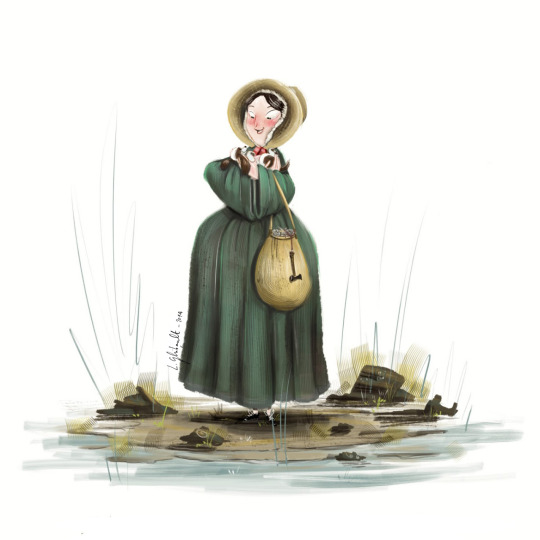
This is an illustration I did in 2014 of Mary Anning, once a fossil hunter.
43 notes
·
View notes
Photo


Mary Anning (1799-1847) was a British paleontologist whose findings of Jurassic fossil beds contributed greatly to scientific knowledge of prehistoric life and the history of the Earth. She made crucial discoveries such as the first ichthyosaur skeleton or the first two plesiosaur skeletons ever found and identified.
Born in a poor family, she started uncovering fossils in order to sell them to tourists and supplement the family income. She became well-known in scientific circles despite her lack of formal education, but was ineligible to join the Geological Society of London because of her gender. Nevertheless, her discoveries helped prove important theories such as evolution and extinction.
624 notes
·
View notes
Photo
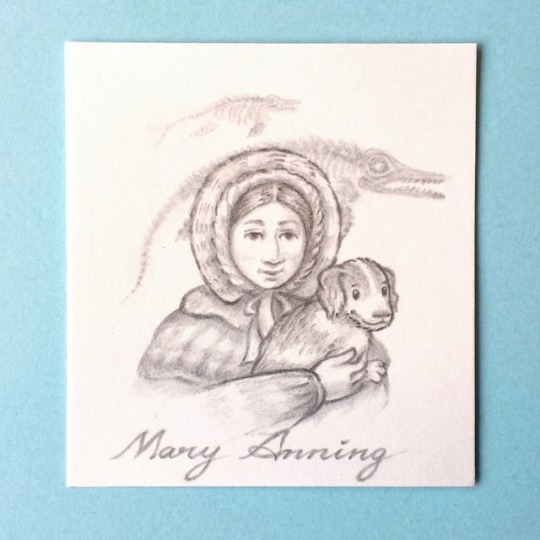
Naturalists of history - Mary Anning and her faithful dog Tray. Anning was a pioneer fossil hunter, her work on Jurassic sea reptiles is legendary. Sadly Tray died in a landslide while accompanying Anning searching the unstable seaside cliffs for fossils. 🐕😢
25 notes
·
View notes
Photo

Forgotten Women Friday #38
Mary Anning- 1799-1847- England
“Persevering Paleontologist”
Mary Anning was a woman whose discoveries helped change our views on prehistoric life and and the history of earth. Anning was born in 1799 in Dorset, Great Britain and her father was a cabinetmaker who also mined the coastal cliff-side for fossils to sell to tourists. She often accompanied her father on his fossil-collecting trips down the cliffs and she became fascinated a young age with the burgeoning science. However, in 1810 her father died after falling from the cliffs, and he left the family in significant debt. The family continued to sell fossils to make money and one year later, Mary’s brother Joseph found an unusual skull while digging at the cliffs. 12-year-old Mary searched for months for the rest of the skeleton, eventually finding it and therefore discovering the first ichthyosaur fossil. The ichthyosaur discovery shocked Western society, as it was still widely believed at this point that the Biblical account of earth’s creation was correct and the planet was only a few thousand years old.
Anning continued the dangerous work of scaling the cliffs for fossils. In 1823, an article in the Bristol Mirror said of her, “This persevering female has for years gone daily in search of fossil remains of importance at every tide, for many miles under the hanging cliffs at Lyme, whose fallen masses are her immediate object.” That same year Anning discovered the first complete Plesiosaurus and in 1828 she found the first British flying lizard known as pterosaurs. In 1826, she opened her own store, Anning’s Fossil Depot. However, despite her scientific success, Anning was largely shut out from the scientific community since she was a poor, working-class woman. The influential Geological Society of London did not allow her to join their ranks and men often took credit for her discoveries in scientific journals. Anna Pinney, a young woman who sometimes accompanied Anning on her expeditions, wrote, “She says the world has used her ill … these men of learning have sucked her brains, and made a great deal of publishing works, of which she furnished the contents, while she derived none of the advantages.“
In 1833, Anning nearly died during a landslide on the cliffs that claimed the life of her beloved dog, Tray. In 1847, Mary Anning lost her battle with breast cancer at the age of 47. Soon after her death, the Geological Society purchased a stained-glass window in her honor and the president of the Geological Society delivered a eulogy for Anning, an honor that had never before been bestowed upon a woman or non-member. Although she faced heavy skepticism during her life, Anning’s discoveries influenced theories of extinction and evolution and helped legitimize the study of paleontology. She is even rumored to be the inspiration behind the famous tongue twister, “She sells seashells by the sea shore.” In 2010, she was recognized by the Royal Society as one of the 10 most influential women scientists in British history.
52 notes
·
View notes
Photo




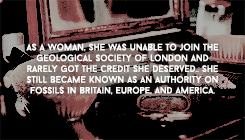
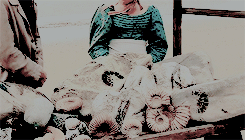
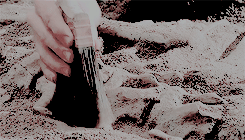

endless list of favourite historical figures ( 2/∾ ) ↳ mary anning
“the carpenter’s daughter has won a name for herself, and has deserved to win it.”
223 notes
·
View notes
Link
How exciting! The film based on Mary Anning’s life and a relationship with a young (fictional) woman has begun setting up in Lyme Regis. Extras should also be getting details about costume fittings throughout this week!
#top posts#Mary Anning#Anning#palaeontology#paleontology#palaeontologist#paleontologist#fossils#fossil#ichthyosaur#plesiosaur#lyme regis#dorset#jurassic#jurassic coast#mary anning rocks#victorian#scientist#women in stem#women in science#lyme online#article#ammonite#kate winslet#saoirse ronan
5 notes
·
View notes
Photo
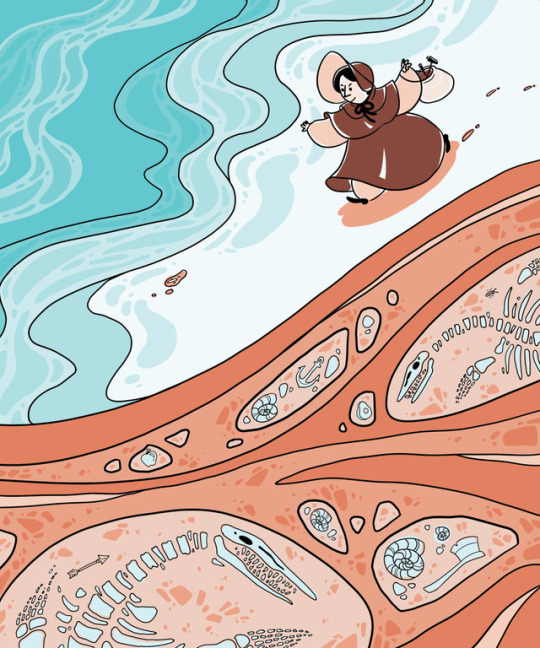
finished mary anning illustration wanted to do a side by side with the cmyk version but?? the files corrupted
63 notes
·
View notes
Photo
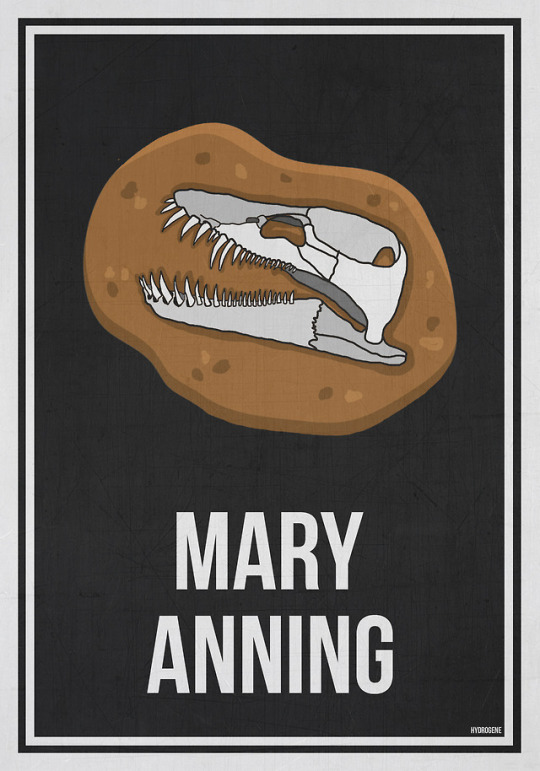
Mary Anning - Women Who Changed Science. And The World.
Paleontologist who made important finds in Jurassic marine fossil beds.
Purchase here!
135 notes
·
View notes